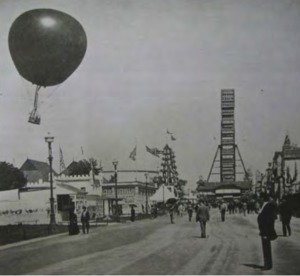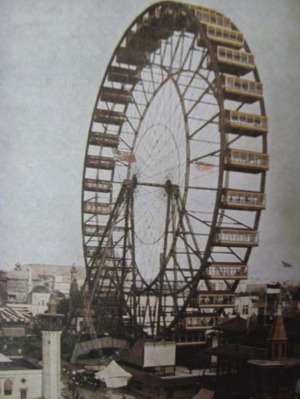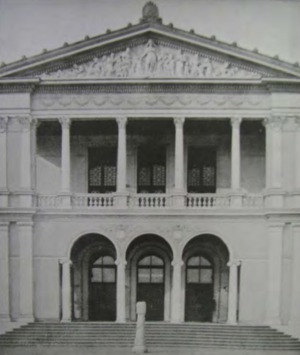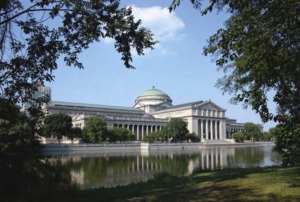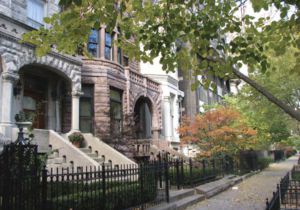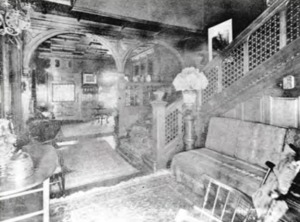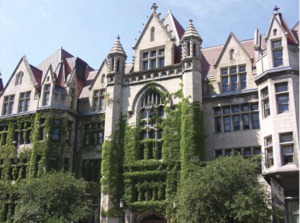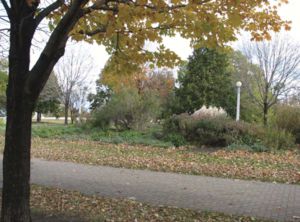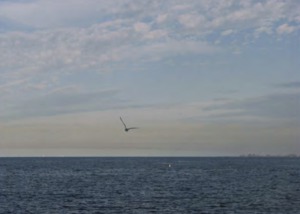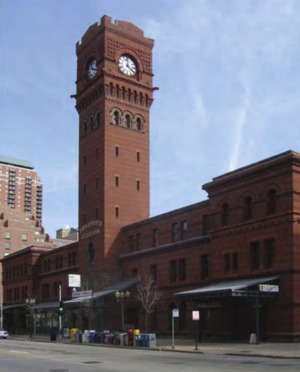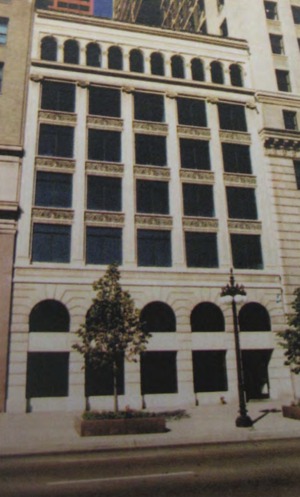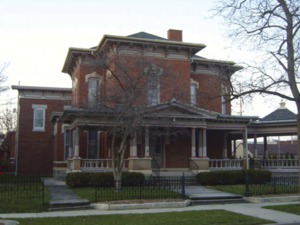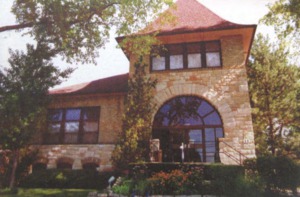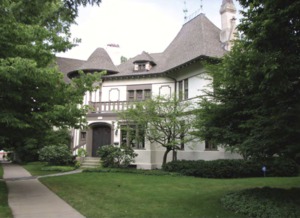Places associated with Swami Vivekananda
The Columbian Exposition
"The Life of Swami Vivekananda by His Eastern and Western disciples" briefly describes Swami Vivekananda's observations reactions at the fair: 'He was struck with amazement at the wonders he saw. Here all the latest products of inventive and artistic minds of the entire world had been brought to a focus, for examination and admiration. He visited the various exposition palaces, marveling at the array of machinery, at the arts and products of many lands, and, at the energy and practical acumen of the human mind as manifested by the exhibits.' Chicago had put its best foot forward to welcome Swami Vivekananda in its own inimitable style.
The Art Institute of Chicago, 111 South Michigan Ave.
Swamiji's most famous discourse ‘In Response to the Welcome Address’ was delivered at the Hall of Columbus at the Art Institute. He spoke several times at the Art Insitute. He attended Charles Bonney's reception here and also led the conference at the Scientific Session of the Parliament. Many additions to the original Art Institute have been constructed over the years, and the interior has been considerably modified. The Hall of Columbus is no longer there. Fullerton Hall now occupies the place where the speaker's platform and a part of the gallery were located.
Midway Plaisance, between Ellis and University Avenues
Swamiji must have visited the Midway several times; either to talk to an Indian finger nail artist, or to take a spin on the Ferris Wheel or to visit the 'East India Bazaar.' The Midway Plaisance, an area surrounded by Stony Island Avenue on the east, Cottage Grove Avenue on the west, and 59th and 60th streets on the north and south respectively, offered fairgoers a chance to amuse themselves and an opportunity to see how the people in other parts of the world lived . It was essentially a 'Bazaar of all nations', and 'the exposition's commercially run entertainment strip'. The Ferris Wheel was a superb engineering feat and could carry more than 2,000 people at one time. The world's first Ferris Wheel was erected at the center of the Midway. Built on speculation by George W. Ferris, a bridge builder from Pittsburgh, the ride was the fair's most prominent engineering marvel. The wheel rose to 264 feet, surpassing the Eiffel Tower, and offering breathtaking views of the fair and the city.
The Women's Building, Jackson Park
Swamiji spoke on "The Condition of Women in India"
at the Women's Building. In charge of this all woman project was a Board of Lady
Managers chaired by Bertha Potter Palmer, a wealthy
and influential patron of the arts. Placing women in
charge of their building was considered a rather
revolutionary idea at the time and was not
enthusiastically supported by some Fair
authorities.
Mrs. Potter Palmer, the president of the Board of Lady
Managers, gave a reception for the delegates on the
evening of September 14, 1893 at the Women's Building
in Jackson Park. Mrs. Palmer delivered an address of
welcome followed by a speech by Mr. Thomas Palmer
(unrelated), president of the World's Columbian
Exposition, who later hosted Swami Vivekananda in his
house in Detroit in 1894.
Art Palace — Museum of Science and Industry, 57th St and Lake Shore Drive
Swami Vivekananda walked in this area, during the
Parliament of World Religions in 1893.
The museum was built as the 'Art Palace' for the
World's Columbian Exposition. The Art Palace was one of
the buildings from the World's Fair that was saved. It
was universally praised as an exemplary work of art.
Designed by the New York architect Charles B. Atwood,
and located on the North Bank of the North Pond, this
was the only building built to last a long time housing
its priceless collection of art. It came to be known as
the Atwood Palace. It was refurbished and became the
Museum of Natural History. In 1934, the Palace of Fine
Arts became the nucleus of what is now known as the
Museum of Science and Industry.
Gold Coast, 1400 — 1600 North Dearbon St.
On the morning of Setember 10, 1893 Swamiji walked east from the Chicago and Northwestern Station. Hungry and tired, he begged for food and directions to the Parliament office as he plodded through the Gold Coast. The Gold Coast area was an exclusive residential neighborhood where the Potter Palmers lived. The people and butlers had no time or sympathy for a strange looking monk, in rumpled clothes and with a travel worn appearance and slammed the doors in his face. Swamiji traveled the entire area of what is now known as the "Gold Coast", still an exclusive residential area.
Hale residence, 1415 North Dearborn St.
Swamiji arrived tired at the north end of Dearborn Avenue, 2 blocks from Lincoln Park. Totally exhausted, he sat down on the curb on the opposite side of the Hale home at 541 Dearborn Avenue. Mrs. Ellen Hale saw him and took Swamiji into her home and heart. She took Swamiji to meet the officials of the Parliament of World's Religions and set the chain of events in motion that would go down in history as the initiation of the Vedanta movement in the West. He stayed here in 1893 (November and December), 1894 (May and June) and 1895 (Janunary). He also asked that all letters written to him should be addressed to the Hale Residence even when he was travelling. The Hale home was demolished in the late 1960's and a high rise apartment complex built on the site. The high rise building now is 1415 North Dearborn Street.
Second Hale residence, 1210 North Astor St.
On his second visit to the West Swamiji stayed with the Hales again. Mary Hale threw a party in Swamiji's honor the day after Swamiji arrived in Chicago. On November 27, 1899 Swamiji gave a lecture at the Hale residence in the form of a parlor talk. The McConnell Building is presently at 1210 N. Astor Street. At the northwest corner of Astor and Division Streets, the building stands tall among the others around it. It is part of the 'Astor Street Historic District' and is located within the Gold Coast area of Chicago.
Cobb Hall, 5811 South Ellis Ave., University of Chicago
The University Chapel was located in Cobb Hall, which exists on the west side of the quadrangle on Ellis Avenue even today, as a part of the original campus of 1892. Cobb Hall was the first building of the University of Chicago, erected with donation by Silas B. Cobb. The University Chapel was on the 1st floor of the building taking up almost all of the north end. The room no longer exists the way it did at the time. It has been converted to four large lecture rooms, two on each side of a hall. Swamiji spoke at the University Chapel on March 1, 1894. The subject of his talk was "Modern Schools of Hinduism".
Lincoln Park
While living with the Hale family, Swamiji went for strolls to Lincoln Park very often. It was here that he did babysitting for a 6 year old child. This child was "Agnes Ewing". She later became a student of Swami Akhilananda at the Boston center. In addition to being a park at the lakefront, Lincoln Park had many other attractions at that time. This 250 acre park was bounded by Lake Michigan on the east; Clark Street on the west; North Avenue on the south, and Diversey Street on the north. The park included a Conservatory, a Zoo which had a Bengal tiger, the Chicago Academy of Sciences and the Lincoln Statue.
Lake Michigan
Swami Vishwananda who was the head of the
Vivekananda Vedanta Society of Chicago from 1938
through 1965 received a letter in 1939 from Sarat
Chandra Chakravorty, a disciple of Swamiji. The letter
revealed this incident associated with Swamiji at Lake
Michigan
... Swamiji once told me that one moonlit night when
he was on the shore of Lake Michigan, his mind began to
merge in Brahman. Suddenly he saw Sri Ramakrishna and
remembered the work for which he had come to this
world. Then his mind came down and again turned
toward the fulfillment of his mission".
Dearborn Station, 47 West Polk St.
Swamiji went to Streator by the Santa Fe railroad and came back by it as well. He had embarked the train at the Dearborn station. Although there were a number of railroad stations in existence in Chicago during that time, it is almost certain that Swamiji used the station on more than one occasion. Since the Santa Fe railroad had used the Dearborn station exclusively, he definitely used it for his trip to California as well. Completed in 1885, the Dearborn Station at the end of South Dearborn Street and West Polk Street is the oldest surviving railroad terminal building in Chicago. Since that time it has lost many parts including a huge cupola on the clock tower and a steeply pitched roof that was destroyed during a fire in 1922. Its shed was removed in the 1960s. The whole station has been restored with only minor changes beyond those mentioned.Its passenger operations ceased in 1971 when it was renovated as office and retail space, and its vast backyard replaced with residential developments.
Hotel Richileu, 318 South Michigan Ave.
On October 27 1893 Swamiji lectured at the Ladies
Fortnightly Club on the subject of Buddhism. The club's
address was 10 Van Buren Street, but their meetings
including the one on October 27, were held in Hotel
Richelieu at 186 S. Michigan.
Shy of publicity the club did not encourage
newspapermen to attend such lectures, neither did it
record its detailed proceedings. The content of
Swamiji's lecture therefore remains unknown. This was a
very prestigious and exclusive club, drawing its
membership from the upper crust of Chicago. The club's
goal was to enhance intellectual and social
culture.
The Hotel was built in 1885, but its front facade was
extensively renovated and some additions were made in
1911. After a subsequent alteration in 1892, it now
stands at 318 S. Michigan Ave.
Hull House, 800 South Halsted St.
The Hull House was set up by Jane Addams and Ellen
Gates as an intellectual oasis where they conducted
movements for political and social reforms. The Hull
Mansion has been designated as Jane Addams Hull - House
Museum. Swamiji's photograph adorns a wall of the room
on the southeast corner of the building. The
inscription says -
"Swami Vivekananda (1893-1902); Indian Social
Reformer; Participates in World's Parliament of
Religions."
Swamiji spoke at the Hull House sometime between
October and December of 1893. The subject of his
speech was 'Economic and Social Conditions in
India'.
Hindsdale Unitarian Church, 11 West Maple St, Hinsdale
The Hinsdale Unitarian Church was favored by
addresses on two Sundays by Swami Vivekananda in 1893.
A group of prominent citizens from Hinsdale got
together in 1887 formed the Unity Church Society,
and decided to build a church. The church was built in
1888 and dedicated in 1889. Rev. Gould invited Swamiji
to speak from the pulpit. A small paragraph in the
Unity, a Unitarian weekly magazine published from
Chicago, said on November 2 —
The pulpit at Hinsdale was filled October 15 and 22
by the Rev. Messrs. Vivekananda and Nagarkar, who
preached with much acceptance to overflowing houses. A
course of lectures by Messrs Vivekananda and Hirai are
also being attended to the full capacity of the
Church.
The Church's name changed to Unitarian from Unity in
the 1930s.
Harbert residence, 1412 Judson Ave., Evanston
Swamiji spoke on the subject "Reincarnation" at the Harbert Residence in Evanston. He pointed out the popular error which exists concerning the passing of humanity into animal forms. He said that "It was a mistaken idea to think that his people were so careful of animals because they thought some former human being was now living in the form of the animal. On the contrary, it is simply a part of their religion to be kind to animals. Reincarnation is either progression, which is advancement to a higher type of manhood, or retrogression, which is the relapse of humanity to a lower plane of living."
Bradley residence, 1745 North Hinman Ave., Evanston
Swamiji visited the Bradley Residence in October of
1893. In his letter to Prof. John H. Wright Swamiji
refers to Prof. Bradley. He writes - "Your friend
Prof. Bradley was very kind to me and he always
cheered me (during the parliament speeches)... I am
going to Evanston tomorrow and hope to see Prof.
Bradley there."
Prof. Bradley lived with his wife Susan Bradley and the
house was a short walk from the Congregational church
Swamiji was invited to. The large house is on the
southeast corner of Hinman and Clark. It is now an
Evanston Landmark. Its unique Tudor style architecture
sets it clearly apart from the other houses around
it.
Elisha Grey residence, 461 Hazel Ave., Highland Park
Immediately following the Parliament, Swamiji was invited to the house of Mr. Elisha Gray. The guests at the vegetarian dinner, given in Swamiji's honor, were some very illustrious scientists and engineers. The British physicist Sir William Thomson (Lord Kelvin), Prof. Hermann Von Helmholtz, Prof. Edourd Hospitalier were all there along with other distinguished people.


